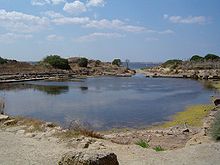Kothon

Kothon ( Cothon ) denotes artificially created harbor basins of antiquity . It is an invention of the Phoenicians .
A kothon is a rectangular basin carved out of the rock that is connected to the sea by a narrow channel. It may have been used as a berth for ships, for their repairs or for loading and unloading.
The largest and best-known kothones are the artificially created port facilities of Carthage : First the ships came through a narrow entrance to the rectangular trading port, a passage at the back led to the circular naval port for 220 ships, in the middle of which on an artificial island there were probably the buildings the Admiralty and / or shipyards found space (as reported by Appian ).
During the conquest of Carthage in 146 BC By the Romans at the end of the Third Punic War , the Kothon was decisive: the Romans sealed off the Kothon with an underwater dam. The Carthaginians then dug a canal from the naval port into the sea. After a final sea battle, the Carthaginians' attention on the Kothon slackened and a Roman unit climbed the defensive wall of the war port, from where they could advance into the city. The Carthaginians then withdrew to the heart of the city and finally had to give up.
The term Kothon probably comes from a Punic word meaning "cut off, cut off". It was later transferred to the man-made harbors.
literature
- Johann Oehler: Kothon 1). In: Paulys Realencyclopadie der classischen Antiquity Science (RE). Volume XI, 2, Stuttgart 1922, Sp. 1516 f.